
Man, sesquicentennial fever has gripped Oregon. Officially launched on Saturday with a kick-off party in Salem and lots of museums and organizations offering free admission, the party is just getting started – year-round events are planned all year to get people of all ages involved in the history of their state. And if the economy keeps tanking there’s going to be a lot more people with idle time on their hands – let’s hope some of the more expensive museums open their doors for free admission during 2009. I’ll certainly do my best to keep, um, “educating” readers about the best state in the union.
Fifty years ago Oregon also partied down and celebrated its 100th birthday. And they did it by holding the Centennial Exposition.
At the time it was the largest fair in the west since San Francisco World’s Fair of 1939. The expo began on June 10 and continued through September 17, 1959.
The exposition promised to “cover all phases of state activity with special attention paid to the basic exhibits of lumber, agriculture, electronics, powers, fashions, food processing, light metals, fishing and sports.” Yep, sounds like Oregon.
An aqua center featured seats for 7,000 spectators, and the promise of “water festivals and spectaculars will be performed on an estuary of the Columbia river adjoining the expo grounds.”
Total space for the expo was 80 acres with parking for over 15,000 cars.
Twenty-four countries participated by exhibiting their products and crafts – and each country were given full reign to get their biz on.
Most of the images in the post come from the official program. Chock full of ads, photos and editorial, the one thing that really sticks out is that many of the photos of the expo feature exhibits still being constructed, renderings of the grounds and lots of dirt paths.
The postcards I have managed to nab throughout the years are obviously more colorful but the traffic in them seems rather low. Three years later Seattle hosted the wonderful 1962 World’s Fair – and got the Space Needle and a monorail. What did we get? I’m not sure if anything still exists from the original grounds. But, I like to think the Oregon Centennial Expo was a bit more scrappy and DIY – kind of like Portland, now.
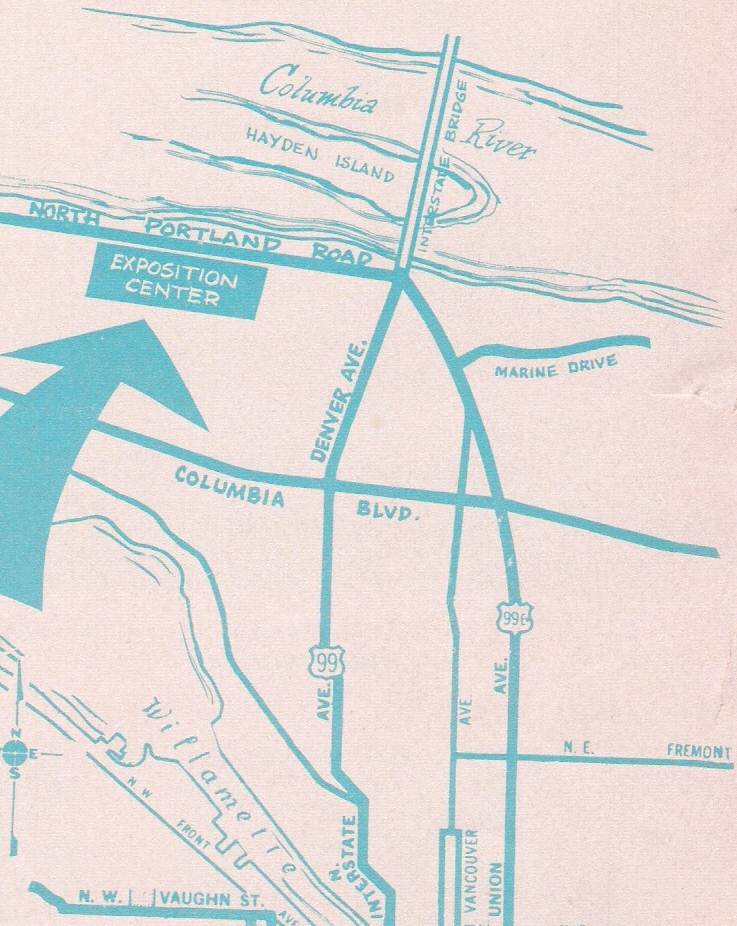 The site of the expo.
The site of the expo.

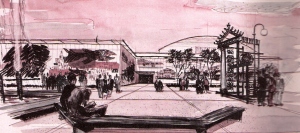 Two renderings, from what I can tell from photos, looked nothing like the completed grounds. Still, very cool style.
Two renderings, from what I can tell from photos, looked nothing like the completed grounds. Still, very cool style.
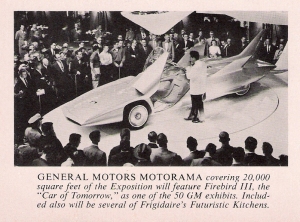 One of many exhibits.
One of many exhibits.
 The big board from the Pacific Telephone display “will show how calls are automatically routed.” Oh, 1959, you slay me.
The big board from the Pacific Telephone display “will show how calls are automatically routed.” Oh, 1959, you slay me.

Modern cafeteria.
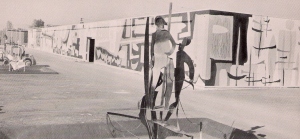 Work still being done on the grounds. This shot shows the East Plaza of the 11-acre Expo building showing vivid [and very MODERN!] 510-foot mural by Hansen Associates covering the entire east wall. Was this mural actually done by muralist Carl Morris?
Work still being done on the grounds. This shot shows the East Plaza of the 11-acre Expo building showing vivid [and very MODERN!] 510-foot mural by Hansen Associates covering the entire east wall. Was this mural actually done by muralist Carl Morris?

The fire sculpture was a 50-foot tower rising from a circular pool of water with gas flames 40 feet high that burned the entire 100 days of the expo. What happened to this?!
Here’s another shot from a postcard:


The top photo was the Lumber Industry Pavilion that was designed as a permanent structure to “show the freedom of expression possible in wood construction.”
Bottom photo is the PGE building of grilled concrete that showed the cycle of water usage from rain storms.
So, back to the Lumber Industry Pavillion and the permanent structure. My wild guess is that it now houses Marineland@ Pier 99 [image from the excellent waymarking.com]. Any clues or ideas? Here’s the original postcard shot for a better shot:
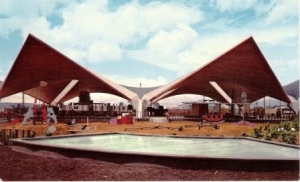
And my favorite structure from the expo:

The Hall of Religious History as seen from the Garden of Tomorrow. “Erected to house the murals of Carl Morris and the exhibits which portray the history of various religious faiths in Oregon.”
I’ve got more Expo imagery that I will be posting throughout the year. It really is one of my favorite Lost Oregon artifacts. Anyone out there want to share a memory of their attendance?

Kind of make Fiesta 200 seem lame. (Obscure San Diego reference)
Just an FYI, I believe the Lumber Industry Pavillion was designed by local architect John Storrs and the Hall of Religious History was designed by Stewart (Donald J.) and Richardson. S & R did a lot of work in Vancouver, WA.
I recently picked up at an antique shop near Lincoln city, a variety of photographers original print proofs of the lumber industry pavillion, in both color and black and white. I’m a huge John Storrs fan, so for me it was an exciting find.
Score!!
Love your blog, I have been ravenously reading since I found it. I have never been a “history buff”, but I really enjoy seeing pictures of how the city looked in the past. Keep em coming!
where are the photos for the gunfights at frontier villiage at they were part of the 1959 expo
I remember those gun fights, I thought they were so cool, but then most 6 year olds at the time did too!
I went to the Centennial Expo with my family. I was nine years old at the time and all I can remember is that we got to ride a train from the parking lot to the Expo and that I saw a wild rabbit in the grass. And people tell me that I have a good memory–there must not have been much at the Expo to interest a child. I remember that my dad liked it.
“not sure if anything still exists from the original grounds…”
Try the Paul Bunyon statue that now sits in Kenton, just south of that original location.
Thanks for that, Ryan. I never really knew where the statue came from. It even has its own Wikipedia entry:
http://en.wikipedia.org/wiki/Paul_Bunyan_Statue
I did not go to the Expo, but do remember growing up that my cousins had an album of a musical written and produced to celebrate Oregon’s centennial.
what was the name of the production? Were Wison and Hubbell responsible for the music?
Thank you for this wonderful blog. I just discovered it, thanks to the article in the Oregonian.
I visited the centennial at age 11 with my family. I have forgotten a lot of it, but now that I see the pictures of the fire sculpture and the murals, I remember them. I remember seeing the new steam locomotive built for the zoo railway running around the site.
As the map shows, it was on the site of what is now the Expo Center. Then it was the Pacific International Livestock Exhibition grounds. The livestock business was already winding down in Portland, and the Centennial Expo was probably a step in transforming the livestock show grounds to its modern use.
I was a visitor to the Expo as a child, too. My aunt, grandmother, mother and I all went in my aunt’s car. We had very little money for eating out, so we ate at Bob’s 15 cent burger drive-ins.
I have 2 souveniers. A cup and saucer printed with the official logo and scenes. But I also have a printout from our first “computer” experience. Pacific Power and Light Company had a Burroughs 205 “Computer” set up. If you typed in your name and the year you were born, it printed out the events going on in Oregon that year.
Great memory, Karleen. And here is a photo of “Dr. K.W.” as the Pacific Power and Light Electronic Brain was known:
http://www.tjsawyer.com/B205Maint.htm
I was 5 1/2 yrs old when we went – I remember being impressed by the gas flame atop the sculpture, and the big wooden tower(s) that had once held the water tanks for Vanport seemed very sinister (maybe because they were associated with the flood – I may have erroneously thought the flood waters had washed the tanks away!). We watched the helicopter rides from the ground (too expensive!) Apart from the trains, the high point was when the neighbors took me to the Centennial Rodeo. They had a ringside box, and at one point a rider got tossed, & the clown distracted the angry bull in our direction, and jumped into our box! I was terrified, and he gave me his hat to quiet me down. I’m sorry it got lost years ago, because the clown was Slim Pickens, I was told. (I’ve been meaning to confirm that he worked the Centennial – I know he had been a rodeo clown before his acting career [Dr Strangelove was three years off]). All in all, a lot of fun!
Did you see the gunfights? If so what do you remember?
About the abstract murals, I immediately thought “Bunce!”
According to
http://www.historycooperative.org/journals/ohq/110.2/curran.html
however,
The mural for the east end of the Centennial building was done by a group called Builders Arts, which included three artists from Oregon and Vancouver: Rick Norwood, Byron Gardner, and Duane Zalondek.22 Stewart and Richardson commissioned local artist Louis Bunce to paint a 22-by-30-foot mural on the Horticulture Building, giving him instructions to create something “suitable for the wall of a garden house.” The third mural project was the most high profile. Costing $10,000, Stewart and Richardson hired Pacific Northwest artist Carl Morris, with the Centennial Commission’s approval, to prepare nine huge canvases to decorate the interior of a planned religious history building. Each 8-by-10-foot painting would depict “an important event in the infusion of religion into human history.”
And who knew we were seeing history at the time. 1959 was as modern as life could be.
Our family never went to the big Centennial set-up in Portland. Dad drove us out to Damascus where they had an eternal flame, staged gun fights, a saloon and other activities. I think it was more kid friendly and certainly not trying to impress anybody. I don’t think it included anything commercial or about “the future.”
I loved the Stan Freberg OREGON! OREGON! radio play commissioned for the Centennial with the witch. Still have the record (Back in the bottle . . .)
The State also held a contest for a centennial song. Our band director entered but didn’t win. The victor, WALKIN’ IN THE OREGON RAIN, was catchy but ultimately forgettable except by those of us who still have the sheet music. (“You can have your hills of old Kentucky, you can having your rolling Texas plains. They’re alright, I’ll agree but I’d much rather be . . . walkin’ in the Oregon rain!”)
The Oregonian ran patterns for making pioneer bonnets for women and my mother, who was pretty handy with a sewing machine, made them for herself and my sister.
I remember something out in Damascus also. Isn’t the structure that was the ‘eternal flame’ still there next to the road, but now it looks like a big candle?
The candle is still there right nex to highway 212 it is noe made of concrete or something and lighted electronicaly. The original candle was made of wax and burned for 100 days.
The wax wax collected by boy scouts and othe groups in the Damascus area. I lived in damascus at that time and spent almost everyday that summer at the frontier town.
Robert Chambers
Mike,
Hi. Are you referring to the Oregon Centennial Song from the celebration in 1959? I believe the winner was “You’re In Oregon My Friend.” I’m pretty sure because my mom was one of the people that wrote and recorded the song.
I was at the cenn. in 1959 with my aunt & uncle. I was 9 at the time. why do I remember this? because, I got lost in the lumber pavilion. when your only 9 this is a big deal, and now I’m 60 but I still remember that day as if it happened yesterday. funny the things we remember.
I didn’t go to the Esposition but I remember that each week a different class got to dress up as pioneers for the entire week. I, of course, dressed as a cowboy. I was 9 at the time. 3 years later I did get to go to the Seattle World’s Fair. What fun for a 12-year-old!
I only vaguely remember attending the centennial in ’59 – I was 4 years old. I do seem to recall a steam-driven belt that (I think) ran a sawmill.
The photos of the Fire Sculpture make me wonder whether it was designed as a sundial: if it were assembled and marked correctly, it seems the shadow of the large arch falling on the inverted curve would mark the date. Anyone know anything about this?
I remember the centenial very well! I was 8 yrs. old. My Dad was a Portland firefighter. The Centenial had a dance contest that spanned many days of the celebration. My parents Kenneth (Kenny) and Emma Kemp won that contest!
I was 10 when my dad took me. Don’t remember much except walking thru a lot of buildings. Dad bought me a few novelties. I do recall that during that time a lot of men grew beards to commemorate the event (you know…the pioneer thing) which, btw, segued neatly right into the up-coming Civil War Centennial which lasted much longer.
There was quite a bit of drama and mystery surrounding the huge mural that created the dramatic entry into the Centennial. I was always told that my father, Rick Norwood, created it but could never find much about his participation in it. The work itself resembles his style of painting quite a bit, and I found a picture of him online, actually working on it. His enamel mural that surrounded the exterior of the Lloyd Center Sheraton Hotel in Portland shows that style as well. It’s a pity that there isn’t more written about it’s creation because it represented the biggest mural ever created at the time. The other interesting thing about it was that many of those who were supposed to have jurisdiction over the spending of allotted funds for the project objected to the abstract theme. In fact it almost seems as if many of them were shocked by it’s very presence on opening day, as if they didn’t even know it was going to be there! Even Louis Bunce, who it seems received the money to create it, was quoted in the only newspaper article that I could find about it, as saying that he had no idea what the mural depicted! There was a fantastic creative vortex emanating from the Portland Art Museum at that time that really changed Portland into the creative, artsy city that it has been ever since. That the Centennial ended up heralding in that movement whether it meant to or not is a fantastic story that definitely deserves to be told! I’d love to hear from anyone that might know more of it.
I am really happy to find information and the memories others have from the Centennial in Portland. I have always had vivid memories of attending with family and sitting on Roy Rogers’ lap. Maybe after a parade? I would have been 5.
I was a 16-year old MHS student in 1959, and during the centennial we were allowed to grow beards.
A hundred years before my maternal family had immigrated from South Africa to Utah. As a teenager my notion of a century was akin to eternity; however, as I find myself having morphed, at light-speed, into my late sixties, a century, as I’m reminded daily, amounts to no more than a brief flickering of a candle.
Do you have any information on the “Oregon Cenetennial Log” when it was on display at the exposition in Portland? I live in Coquille, Coos County, Oregon, near where the log was harvested. It was put on display near here, briefly, before being shipped by rail to Portland. I have some pictures
Does anyone have any information on any homes that were built for the Oregon centennial? I have heard that several homes were built to celebrate the Pacific Northwest …mid century post and beam, Alcoa aluminum, etc.
Would appreciate any info..thanks
I’m late to the game on this topic, but thanks to everyone for all the information about the Centennial, especially the art works. One correction: the correct spelling for one of the Builders Arts guys is Duane Zaloudek. He lives in NY now. My father, Lee Kelly, was another artist who had an art project. Because so many of the artists were young, there was indeed an uproar over these commissions. Lee quit the Museum Art School over it! Ah, what times. I agree with Robyn Norwood about how this one event changed Portland.
Hi there! I’m researching a Portland graphic designer from the 60s named Charles Politz. He was supposed to have had a hand in designing some of the Centennial setups, specifically a photography exhibit. Would you happen to have any info on that?
Thank you in advance, thanks for sharing your pics!